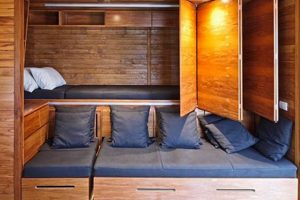A self-constructed sleeping platform that incorporates a secondary, roll-away bed stored beneath it represents a practical space-saving solution. This configuration typically features a primary bed frame elevated sufficiently to accommodate a smaller bed frame, often on casters, which can be easily pulled out for use and then retracted for storage. An example would be building a twin-sized bed frame with enough vertical clearance to house another twin-sized mattress and rolling frame underneath.
The appeal of creating such a piece lies in its adaptability and potential cost savings. It allows for maximizing floor space, particularly beneficial in smaller rooms or apartments, by providing sleeping arrangements for occasional guests without permanently dedicating space. Historically, such designs have been implemented in childrens rooms and guest rooms, evolving with trends in minimalist living and the desire for multi-functional furniture. The reduction in expense compared to purchasing pre-made furniture of similar design is a significant advantage.
This exploration will delve into the considerations for designing and building such a structure. The article will cover essential aspects like material selection, structural integrity, safety protocols, and design options. Additionally, different mechanisms for the under-bed components movement and storage will be examined, offering a comprehensive guide for those considering undertaking such a project.
Construction Considerations
Successful construction necessitates careful planning and execution. The following considerations are crucial for ensuring the structural integrity, safety, and functionality of the finished product.
Tip 1: Material Selection. Lumber choice significantly impacts both aesthetics and structural stability. Opt for hardwoods like maple or oak for load-bearing components, providing enhanced durability. Softwoods such as pine can be employed for decorative elements, provided they are adequately supported. Prioritize kiln-dried lumber to minimize warping and cracking.
Tip 2: Precise Measurements. Accurate measurements are paramount. Begin by determining the dimensions of the mattresses intended for both the primary bed and the under-bed unit. Account for adequate clearance to facilitate smooth movement of the lower bed. Subtracting at least 1-2 inches for each dimension is necessary so as not to scrape the bottom bed.
Tip 3: Robust Frame Construction. The main frame must be able to bear the weight of occupants and withstand repeated use. Employ strong joinery techniques, such as mortise-and-tenon or dowel joints, reinforced with screws and wood glue. Ensure all corners are square and adequately braced.
Tip 4: Smooth Rolling Mechanism. The under-bed component’s rolling mechanism requires careful selection. Heavy-duty casters with smooth-rolling bearings are essential for ease of use and longevity. Consider adding locking casters to prevent unwanted movement when the under-bed is in use. Ensure that there is no protruding screw or nail that may cause scratching to flooring.
Tip 5: Safety Considerations. Implement safety features to mitigate potential hazards. Rounding sharp edges and corners reduces the risk of injury. If the structure is intended for children, consider incorporating safety rails. Ensure all fasteners are countersunk to prevent snagging. Use non-toxic finishes.
Tip 6: Adequate Support System. Employing a suitable support system for both mattresses is vital. Slatted supports are an effective means of promoting airflow and distributing weight evenly. Ensure the slats are securely fastened to the frame and spaced appropriately to prevent mattress sagging. Consider adding a center support beam for added stability.
Tip 7: Finishing and Sealing. Proper finishing protects the wood and enhances its appearance. Sand all surfaces smooth before applying a stain, paint, or sealant. Choose finishes that are durable and resistant to wear and tear. Multiple coats may be necessary to achieve the desired level of protection. Consider using water-based finishes due to lower VOCs.
The implementation of these tips will help ensure a safe, functional, and aesthetically pleasing final product, offering a practical and stylish sleeping solution.
The subsequent sections will address specific design considerations and aesthetic possibilities, building upon this foundation of construction knowledge.
1. Structural Integrity
The structural integrity of a self-constructed bed with an integrated roll-away bed is paramount to its safe and reliable function. This factor dictates the bed’s ability to withstand both static and dynamic loads imposed by occupants, mattresses, and the rolling mechanism. Insufficient structural design can lead to component failure, resulting in collapse, injury, or functional impairment of the rolling feature. For instance, a frame constructed from inadequately sized lumber or employing weak joinery techniques will likely sag over time, compromising the mattress support and potentially impeding the trundle bed’s smooth operation. The design must account for the combined weight of the upper and lower beds, especially when both are occupied.
The specific requirements for structural robustness vary depending on factors such as the intended users (adults or children), the size of the mattresses, and the materials utilized. However, certain principles remain constant. Corner joints, where vertical and horizontal frame members intersect, are particularly vulnerable and require reinforcement through techniques such as mortise-and-tenon joints, metal brackets, or robust screw connections. The weight-bearing capacity of the support structure beneath both mattresses is also critical; closely spaced slats or a solid platform of sufficient thickness are essential to prevent sagging and ensure even weight distribution. Consider the scenario where a self-built bunk bed with an integrated trundle bed lacks adequate bracing: this would result in instability and a hazardous environment for users.
In summary, a solid and stable build is not an optional aesthetic choice but a core functional and safety requirement for any self-constructed bed with an integrated roll-away bed. Compromising structural integrity to save on material costs or construction time can have serious ramifications. A thorough understanding of load-bearing principles, appropriate material selection, and the utilization of sound construction techniques are essential for creating a safe and durable piece of furniture. The effort invested in ensuring structural soundness will translate directly into the longevity and reliable performance of the finished bed.
2. Rolling Mechanism
The effectiveness of a self-assembled bed with a secondary, storable bed beneath is intrinsically linked to the quality and design of its rolling mechanism. This component is responsible for facilitating the smooth and effortless extension and retraction of the trundle bed, directly impacting user convenience and the long-term usability of the overall structure. A poorly designed or constructed rolling mechanism can result in difficult operation, potential damage to flooring, and premature wear and tear on the bed frame itself. For example, casters with insufficient load ratings may bind under the weight of the mattress and occupant, rendering the trundle bed difficult to move. Conversely, a well-engineered mechanism, featuring heavy-duty casters with smooth-rolling bearings, ensures ease of use and prolongs the lifespan of the furniture. The rolling mechanism’s performance is therefore a critical determinant of the project’s success.
Practical considerations for the rolling mechanism extend beyond the selection of appropriate casters. The design must account for adequate clearance between the trundle bed frame and the underside of the main bed frame, preventing friction and binding during operation. Reinforcement of the trundle bed frame at caster mounting points is essential to distribute the load and prevent structural failure. The use of guide rails or tracks can further enhance stability and ensure consistent alignment during extension and retraction. Consider the scenario of a guest room where space is limited: a well-functioning rolling mechanism enables quick and easy deployment of the additional sleeping space, maximizing the room’s utility. Without a reliable system, the entire bed build fails.
In conclusion, the rolling mechanism is not merely an ancillary component but a core element of the overall design. Its performance dictates the practicality and longevity of the unit. A thoughtful approach to caster selection, frame reinforcement, and clearance considerations is essential for a smooth and functional experience. Addressing these factors ensures that the self-built bed with an integrated roll-away bed offers a practical and space-saving sleeping solution for many years.
3. Material Quality
The selection of materials for a self-constructed bed featuring a trundle significantly impacts the final product’s durability, safety, and aesthetic appeal. The choice of wood, fasteners, and finishes directly influences the bed’s structural integrity and resistance to wear. Inferior materials, such as low-grade lumber with knots or inadequate hardware, compromise the frame’s stability and increase the risk of collapse under weight. Consider, for instance, a bed built with particleboard; its susceptibility to moisture damage and inability to securely hold fasteners renders it unsuitable for a structure intended to support substantial weight and withstand frequent use. Conversely, using kiln-dried hardwood like maple or oak for load-bearing components offers superior strength and longevity.
Beyond structural considerations, material quality extends to the aesthetic and functional aspects of the roll-away bed. The finish applied to the wood protects it from scratches, stains, and moisture damage, prolonging its lifespan and maintaining its appearance. Non-toxic finishes are particularly important, especially for beds intended for children, mitigating potential health risks associated with chemical off-gassing. The choice of casters for the trundle bed also falls under material quality; high-quality, smooth-rolling casters protect flooring and ensure effortless operation, while inexpensive casters may damage surfaces or become difficult to maneuver. The type of wood affects the rolling smoothness of the wheels.
In summation, material quality is not a mere cosmetic consideration but a fundamental aspect of a durable self-constructed bed, which features a pull-out type. Compromising on materials to reduce initial costs can lead to premature failure, requiring costly repairs or replacement. Prioritizing high-quality materials ensures a safe, functional, and aesthetically pleasing piece of furniture that provides long-term value and enhances the overall living space. These benefits include the physical health and safety of the person occupying the build.
4. Space Optimization
A significant driver behind the construction of a self-assembled bed with a storable trundle is the optimization of available space, particularly in dwellings with limited square footage. The design inherently addresses the challenge of accommodating occasional overnight guests or multiple occupants within a single room without permanently sacrificing valuable floor area. The storable trundle allows for the allocation of space primarily for daytime activities, transforming it into a sleeping area as needed. Therefore, a direct causal relationship exists between the desire for effective space utilization and the implementation of such a bed design.
The effectiveness of space optimization through this method is evident in various residential settings. In compact urban apartments, a self-built bed with an integrated trundle provides a dual-purpose solution, serving as a single bed for daily use and readily expanding to accommodate visitors. Children’s bedrooms, often constrained in size, benefit from this design, allowing for play space during the day while providing sleeping arrangements for siblings or sleepovers. Furthermore, the customizable nature of construction allows the bed to be tailored to specific room dimensions, ensuring efficient integration with existing furniture and architectural features. This customization contrasts with pre-fabricated furniture, which may not fully optimize the available area.
In conclusion, space optimization constitutes a primary functional benefit of a self-assembled bed with a pull-out bed, directly addressing the need for flexible and efficient utilization of residential space. The design’s adaptability and inherent space-saving characteristics make it a practical choice for maximizing the utility of smaller living spaces. The success of such a project hinges on careful planning and precise execution, ensuring the final product seamlessly integrates into the room and effectively serves its dual purpose. Achieving this requires attention to dimension, design, and rolling mechanism functionality, but the rewards are great to the end user!
5. Safety Standards
The adherence to established safety standards is of paramount importance when undertaking the construction of a self-assembled bed featuring a trundle. Such projects, while offering customizability and potential cost savings, necessitate a rigorous consideration of safety protocols to mitigate risks associated with structural integrity, material toxicity, and potential hazards to occupants.
- Structural Stability and Load Capacity
Adequate structural stability is crucial to prevent collapse or failure under load. Safety standards dictate the use of appropriately sized lumber, robust joinery techniques, and secure fastening methods to ensure the bed can safely support the weight of occupants and mattresses. Neglecting these standards can result in instability, posing a significant risk of injury. For instance, inadequate slat spacing or insufficient frame support could lead to mattress sagging or complete structural failure.
- Material Toxicity and VOC Emissions
Safety standards mandate the use of non-toxic materials, particularly finishes and adhesives, to minimize exposure to harmful chemicals. Volatile organic compounds (VOCs) emitted from certain paints, stains, and glues can pose health risks, especially in enclosed sleeping environments. Adhering to established VOC limits and selecting certified low-emission products is essential for ensuring a safe and healthy sleeping environment. Using water-based products will minimize this risk.
- Edge and Corner Treatment
Sharp edges and corners present a significant risk of injury, particularly for children. Safety standards require the rounding or softening of all exposed edges and corners to minimize the potential for cuts and bruises. This can be achieved through sanding, routing, or the application of edge banding. Neglecting this aspect can transform an otherwise functional piece of furniture into a potential hazard. Safety should be the number one consideration.
- Trundle Bed Mechanism Safety
The trundle bed mechanism must operate smoothly and safely to prevent pinching or entrapment hazards. Safety standards dictate the use of heavy-duty, smooth-rolling casters with locking mechanisms to prevent unintended movement. Clearances between the trundle bed frame and the main bed frame must be sufficient to avoid pinching, and safety stops should be incorporated to prevent the trundle bed from rolling out completely. Any mechanism must have safety in mind.
The integration of these safety facets represents a critical component in the planning and execution of constructing a sleeping platform and secondary bed storage build. By diligently adhering to established safety standards, builders can significantly reduce the risks associated with structural failure, material toxicity, and potential hazards, ensuring a safe and functional piece of furniture that provides long-term value and peace of mind.
Frequently Asked Questions
The following questions address common concerns and misconceptions regarding the construction of a self-assembled sleeping structure with a secondary roll-away bed underneath.
Question 1: What is the minimum recommended height for the primary bed frame to accommodate a standard trundle unit?
The vertical clearance between the floor and the bottom of the primary bed frame must be sufficient to house the trundle bed, its mattress, and the rolling mechanism. A minimum clearance of 12 to 14 inches is generally recommended to accommodate a standard trundle unit and facilitate smooth operation. However, the precise measurement depends on the thickness of the trundle mattress and the height of the casters.
Question 2: What type of wood is most suitable for constructing a structure with a roll-out bed underneath?
Hardwoods, such as maple or oak, are preferred for load-bearing components due to their superior strength and durability. Softwoods, such as pine, can be used for non-structural elements. It is crucial to use kiln-dried lumber to minimize warping and ensure dimensional stability.
Question 3: What is the recommended weight capacity for the casters used on the trundle frame?
The combined weight of the trundle bed frame, mattress, and anticipated occupant load must be considered when selecting casters. The total weight capacity of the casters should exceed the anticipated load by a significant margin to ensure smooth operation and prevent premature failure. Heavy-duty casters with a weight capacity of at least 75 pounds per caster are generally recommended.
Question 4: How can one ensure the trundle unit rolls smoothly and without damaging flooring?
The selection of appropriate casters is crucial. Opt for non-marking, rubberized casters that distribute weight evenly and minimize friction. Regularly inspect and maintain the casters to ensure they are clean and free of debris. The addition of a track or guide system can also improve stability and prevent lateral movement.
Question 5: What safety precautions should be taken during the construction process?
Eye protection, respiratory protection, and appropriate work gloves are essential when cutting, sanding, and finishing wood. Work in a well-ventilated area to minimize exposure to dust and fumes. Ensure all power tools are properly grounded and used according to the manufacturer’s instructions. Take frequent breaks.
Question 6: How can one prevent the trundle from rolling out unintentionally?
The implementation of locking casters is a simple and effective solution. Alternatively, a latching mechanism can be installed to secure the trundle unit in its retracted position. This prevents accidental deployment, particularly on uneven flooring.
Careful planning, attention to detail, and adherence to safety protocols are essential for a successful sleeping and storage configuration construction project. This ensures a safe, functional, and aesthetically pleasing addition to any living space.
The next section will explore design variations and personalization options.
Conclusion
The exploration of the self-constructed bed with integrated, storable bed below reveals a multifaceted undertaking. It involves careful planning, material selection, and precise execution. Key aspects, including structural integrity, rolling mechanism functionality, material quality, space optimization, and adherence to safety standards, are paramount for a successful outcome. Addressing these considerations ensures a safe, functional, and aesthetically pleasing final product.
The benefits of undertaking such a project extend beyond mere cost savings, encompassing customization and efficient space utilization. Thorough research, adherence to established guidelines, and a commitment to quality workmanship are essential for realizing the full potential of a self-built sleeping and storable bed platform. Proceed with informed diligence to create a lasting and valuable addition to the home.


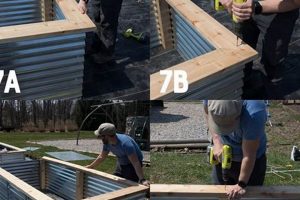
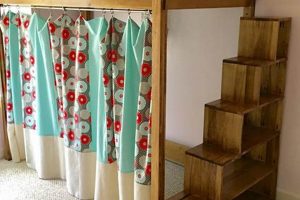
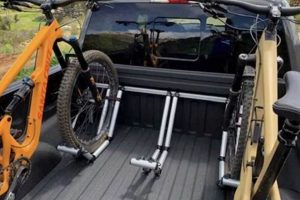
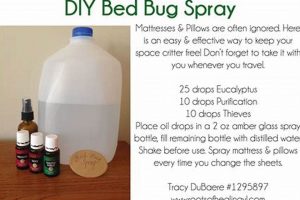
![DIY Wood Truck Bed: Build a Custom Wooden Bed [Guide] The DIY Hub: Creative Crafts, Repairs & Life Hacks DIY Wood Truck Bed: Build a Custom Wooden Bed [Guide] | The DIY Hub: Creative Crafts, Repairs & Life Hacks](https://craftingdiycenter.com/wp-content/uploads/2025/07/th-2390-300x200.jpg)
